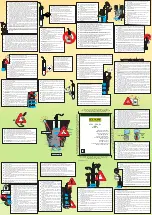
24 PCM
+
Operation Manual
8.7 Interpreting survey results
Taking a classical situation as shown in Figure 8.1,
graph ‘A’ shows the ideal response which is a loss of
signal current and a step response, but excludes any
effects from fault currents in the ground.
In practice, the results obtained require some
interpretation because sometimes the magnetic field
detected from the pipe may be affected by other signal
paths in the ground, including around the position of
coating defects.
Graph ‘B’ shows the theoretical effects of the fault current
in the ground. Note that the local fault current enters the
pipe from both directions and this distorts the magnetic
field around the pipeline close to the fault. A short
distance from the fault the ground currents subtract from
the pipe current, which is measured as current reduction.
A short distance after the fault they add to the pipe
current, which is measured as current increase. At some
distance from the fault, current settles to a steady state.
If this local effect is observed, it is useful for detecting
defects.
Graph ‘C’ shows what would be expected in the real
situation if PCM
+
currents were plotted over a section of
pipe with a coating defect.
Depending on the fault characteristics, the effect of the
magnetic field distortion will spread over a distance of
perhaps 2 to 10 meters either side of the fault, and the
effect will vary depending on the type and severity of
the fault.
A fault caused by the surveyed pipeline being in contact
with another structure, such as another pipe or cable
running across the pipeline, will show some distortion of
the magnetic field directly over the contact, but is unlikely
to show the rise in current after the fault.
These effects are more noticeable when the survey is
performed over a short distance either side of a fault.
This highlights the need to perform surveys over a
complete section before attempting a more detailed
survey of suspect areas.
fault
Fault current opposite to pipe current
Fault current same direction as pipe current
pipe
A
B
C
mA
Distance
TX
Figure 8.1: Interpreting results




































